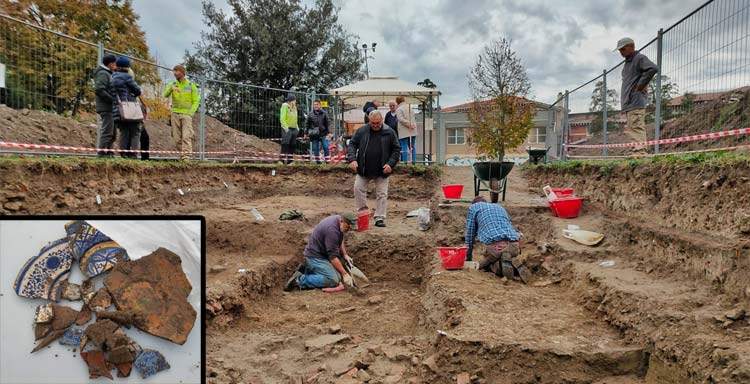Ferrara, 16th century landfill discovered at the site of the Delizia di Belfiore
Important discovery in Ferrara where, from the first of three planned excavation campaigns on the site of the Delizia di Belfiore (the ancient Este residence built in the late 14th century and considered among the family’s most splendid: known to have housed Leonello d’Este’s famous studiolo, was located at the end of what is now Corso Ercole I, and was completely destroyed by fire in 1632), a 16th-century "butto ," or dump of objects, such as ceramics, glass, metals and remains of meals, was uncovered inside a hole dug in the ground located today at a depth of about five feet. A kind of ancient landfill, in short: such finds have been crucial in the past to learn about the habits of people living in ancient times, and have also resulted in the discovery of interesting archaeological finds.
The discovery took place as part of the Che Delizia Belfiore! project, which was created at the initiative of the superintendence, with the (three-year) contribution of the Municipality of Ferrara, which has already allocated 37,500 euros for this purpose. Also participating are the Province of Ferrara, which is granting the authorizations for excavations on its own land and its patronage, and the Ferrara Pianura Reclamation Consortium, which has built the fencing of the area. The project involved about a hundred students from the local Roiti and Ariosto high schools and volunteers from the Gruppo Archeologico Ferrarese, who, guided by professional archaeologists, took part in the work during these first five weeks of the campaign, finding several finds and, most recently, the very “butto,” which has already been defined as very useful for historical analysis and which brought out crockery, fragments of sixteenth-century chalices, finely decorated glazed pottery and perhaps of Faentine workmanship, glassware, pieces of graffitied pottery.
In the same tank, food remains (fish, oysters, poultry) also came to light, which will further detail knowledge about the daily life and “gastronomic” customs of the time. Finds that are in addition to other findings that have already emerged from the start-up phases of the construction site, including: portions of floors and walls blackened by flames, roof tiles, column bases, fragments of plaster, elements with marbled decorations, some coins, including one even from the time of Leonello d’Este.
In these first weeks of the project, Ariosto students have been working in the field, while young people from Roiti High School have been helping to clean, map and catalogue the finds, with work that will continue beyond the first phase of excavation. The next campaign, which is likely to start in the spring of 2023, will see students from the two high schools in reversed roles to allow students to sample the full cycle of an archaeological work. Now the excavated area will be covered with earth, as is customary to protect the underground structures found,and from next spring, building on the knowledge gained, new areas will be identified for investigation. In the meantime, meetings are being scheduled with citizens to tell them about what has been discovered and the next steps of intervention. At the same time, students will deepen their work in the classroom, collaborate on a final document and a popularization project.
“Already at the first excavation campaign, the results are beyond our wildest expectations,” says Dr. Chiara Guarnieri, coordinator of the project and of the team of archaeologists composed of Flavia Amato, Maurizio Molinari and Marco Bruni. “We have in fact identified,” she explains, “finds that have allowed us to clearly acquire new useful information related to well-defined historical events and materials that open up further prospects for discovery.”
To all, Mayor Alan Fabbri expresses his “heartfelt congratulations and thanks for the work done. We believe so much in the potential of this project, unique in its kind and deserving to be ’exported’. It is a project that combines field training, study and commitment to historical research, appreciation of our past, acquisition of new skills, and sociality, with the beauty of discovery and the usefulness of a work that is broadening the field of knowledge related to a vanished delight and those who lived there.”
 |
| Ferrara, 16th century landfill discovered at the site of the Delizia di Belfiore |
Warning: the translation into English of the original Italian article was created using automatic tools. We undertake to review all articles, but we do not guarantee the total absence of inaccuracies in the translation due to the program. You can find the original by clicking on the ITA button. If you find any mistake,please contact us.





























